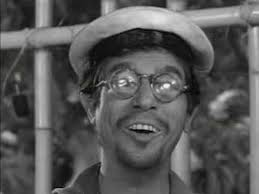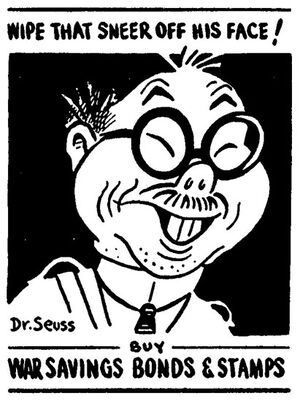
Vito Scotti as the Japanese Sailor.
Bio[]
The Japanese Sailor is a forty-to-fifty-year-old Japanese Navy ensign who has been patrolling the waters around island in his one-man submarine since World War Two. His true name is unrevealed, but since his radio broke, he has been cut off from communication from his superiors and is completely unaware that the war has ended. He is quite adept at English, having attended UCLA and having watched captured American movies starring John Wayne. On the island, he captures all of the castaways except for Gilligan and the Skipper and puts them in bamboo cages booby-trapped with live grenades. However, Gilligan waits for the sailor to fall asleep in order to steal his rifle and eyeglasses, rescuing everyone as a result while the Skipper is trying to dig everyone out of the cages. The sailor flees the island, struggling to reach the ocean from the lagoon without his glasses. Several months later, the Skipper, Ginger and Mr. Howell remember their escape from the sailor much differently than Gilligan's memory of the incident.
Trivia[]
- The Japanese Sailor was played by character actor Vito Scotti who returned in the second season playing Dr. Boris Balinkoff in the episode The Friendly Physician.

A WWII era political cartoon drawn by Dr. Seuss.
- The portrayal of the Japanese Soldier is often considered insensitive since it calls upon common themes and racist portrayals in U.S. following WWII-era propaganda films and cartoons. As a result, the episode is sometimes left out of syndication rotation in some markets due to the perceived racially insensitive nature of the character; especially since the character was played by Vito Scotti instead of an actor of Japanese or East Asian descent.
- Since the sailor has been cruising around the island since World War II, it's unrevealed how he escaped capture by the Air Force who used the island as a landing strip in Gilligan canon or how Wrongway Feldman and Dubov avoided getting captured by him.
- The Japanese Sailor is likely based on the story of Hiroo Onoda, a Japanese soldier who remained on duty in the Philippines for more than twenty years after the end of World War Two.
- The Japanese Navy did use midget submarines similar to the one depicted in the episode. They had a crew of two to three and were launched from larger submarines. The midget subs had a range of less than 100 nautical miles before their batteries required recharging.
- The latter episode with the Skipper, Ginger and Mr. Howell telling different stories of the same encounter is a likely allusion to the 1950 Akira Kurosawa film, "Rashomon," in which the characters each recall the same event differently.